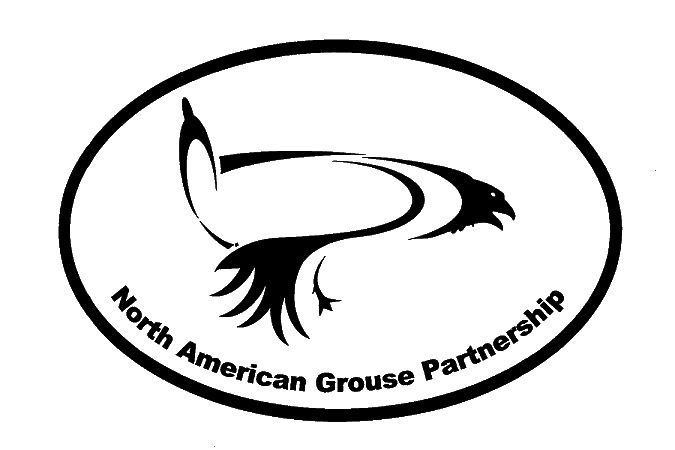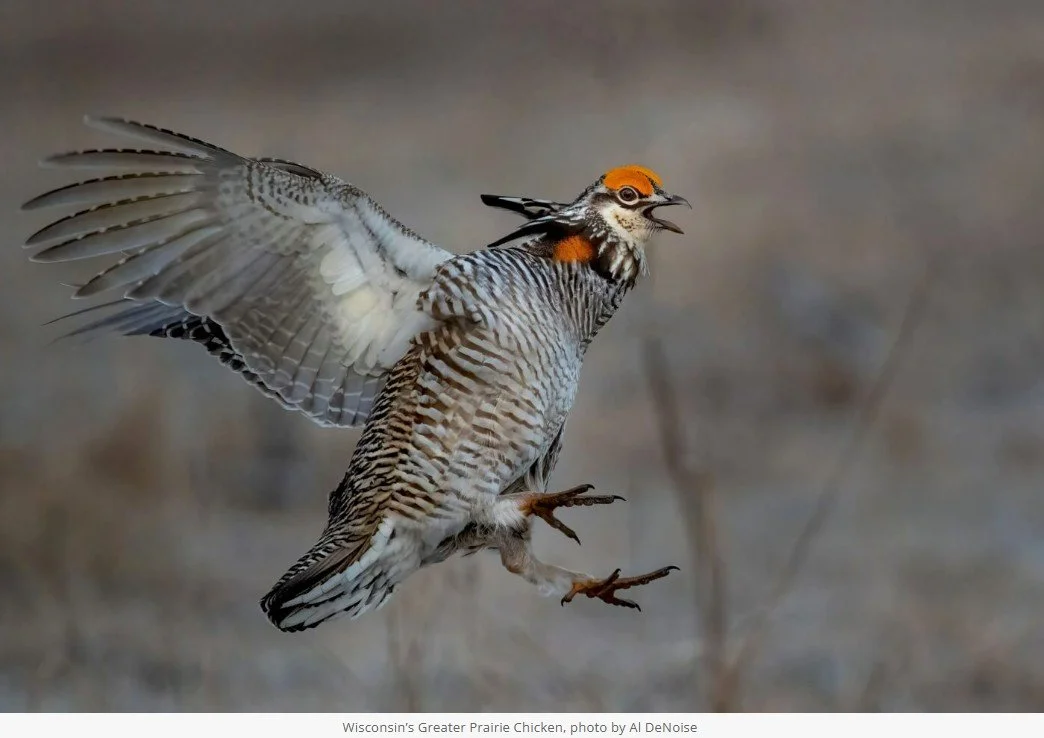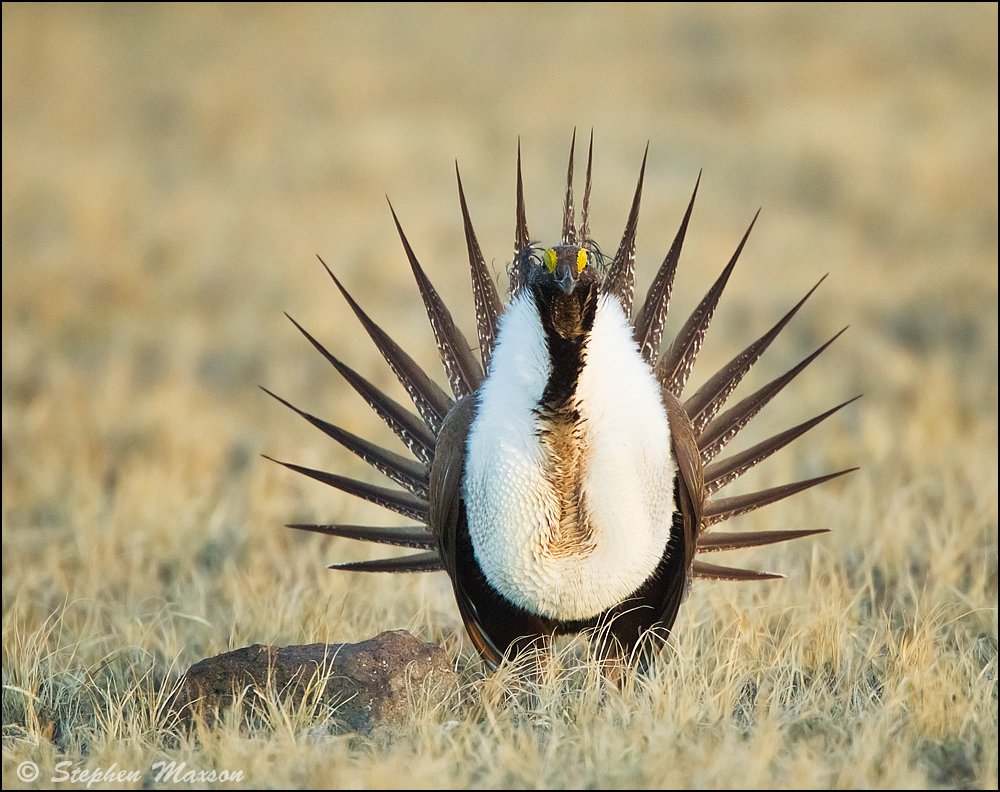WELCOME TO THE NORTH AMERICAN GROUSE PARTNERSHIP
"...the grouse represents only a millionth of either the mass or the energy of an acre.
Yet subtract the grouse and the whole thing is dead.”
- Aldo Leopold, A Sand County Almanac , 1949
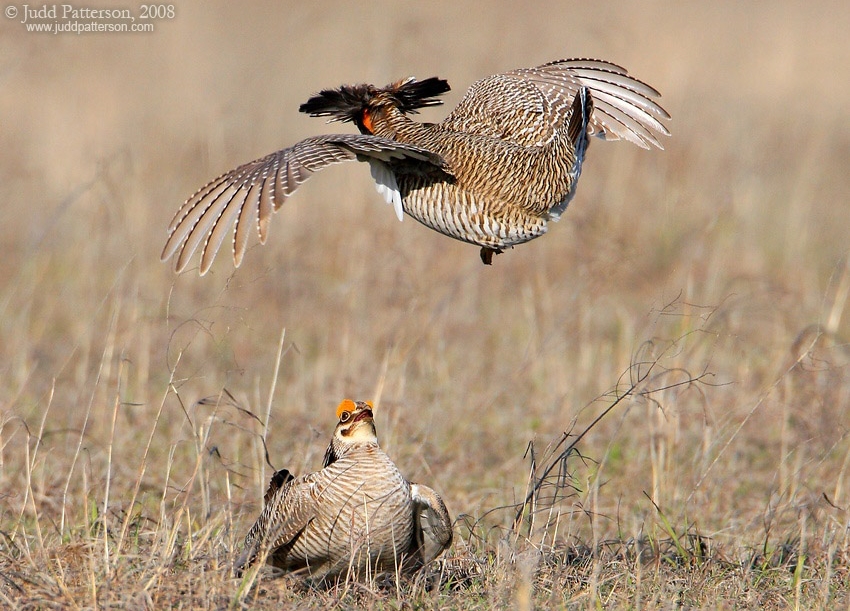

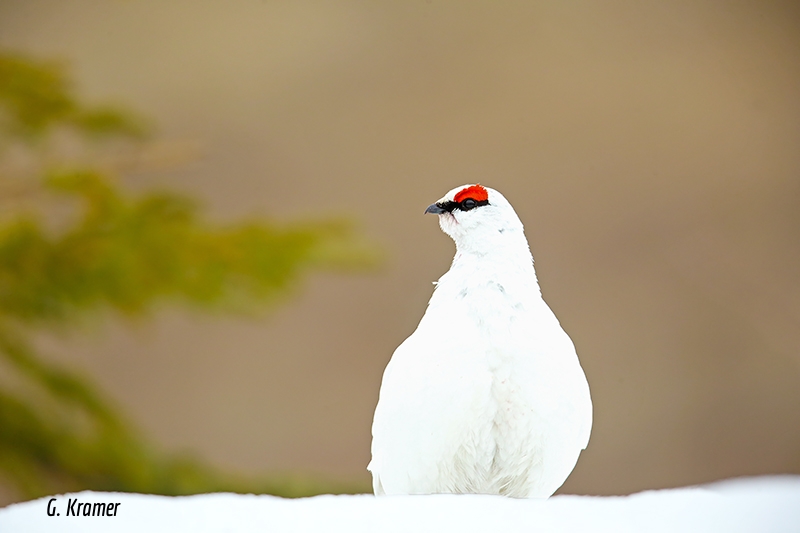

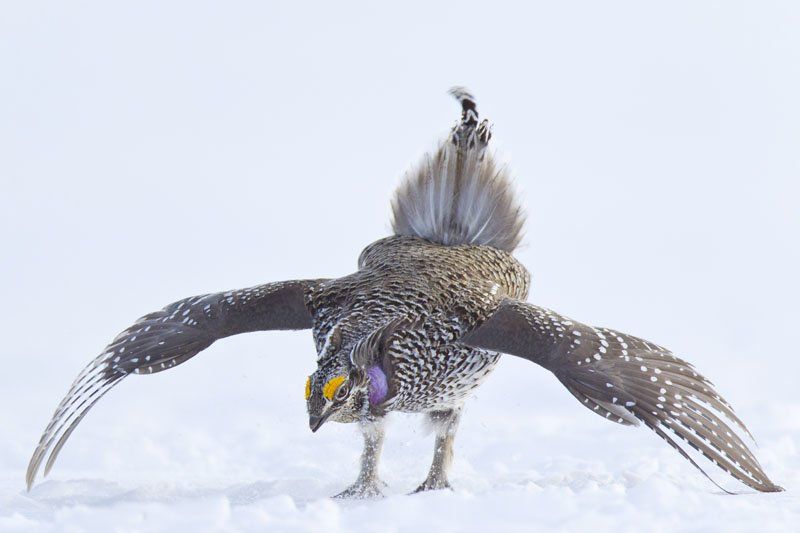
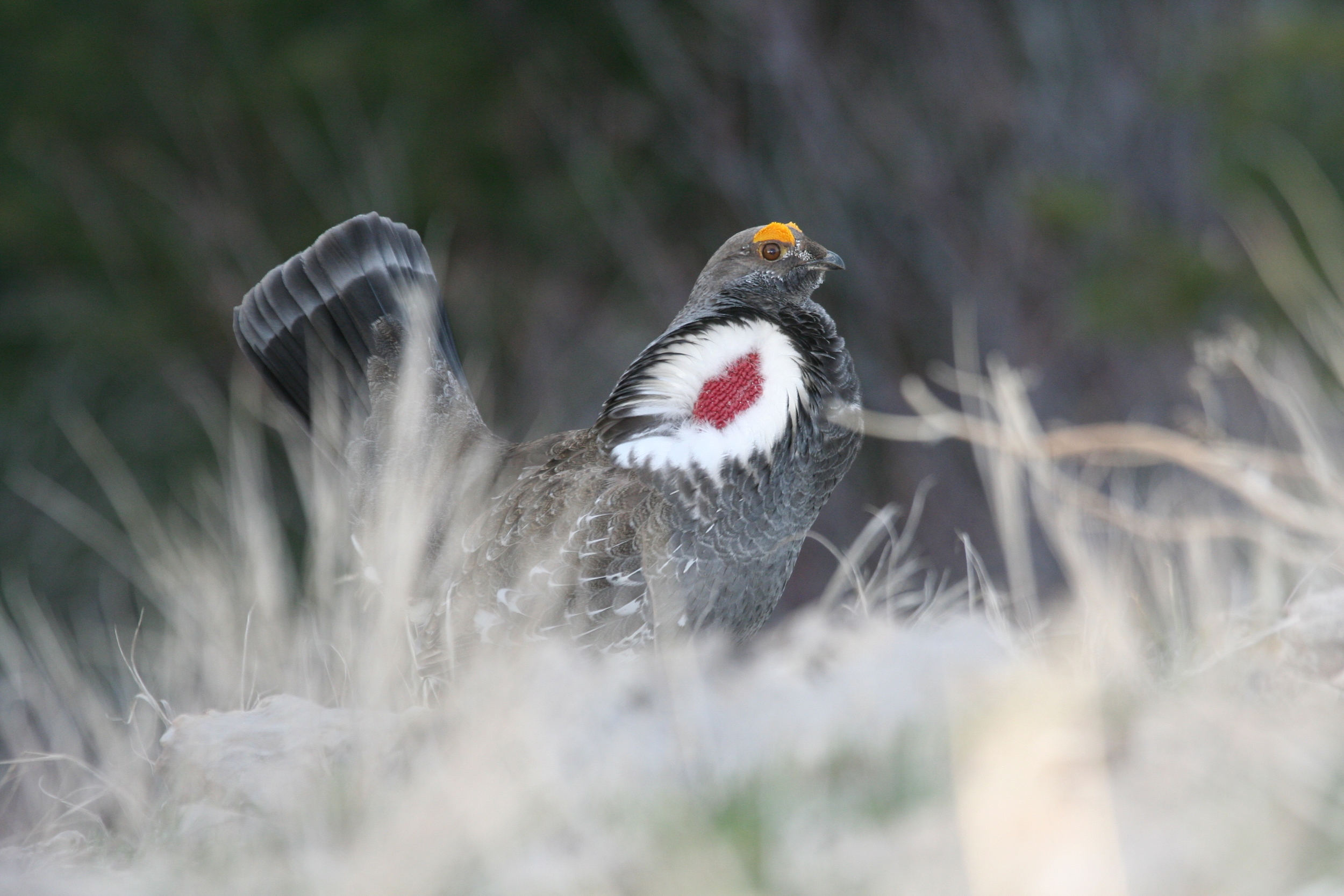
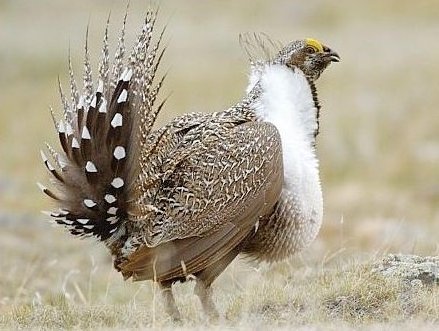
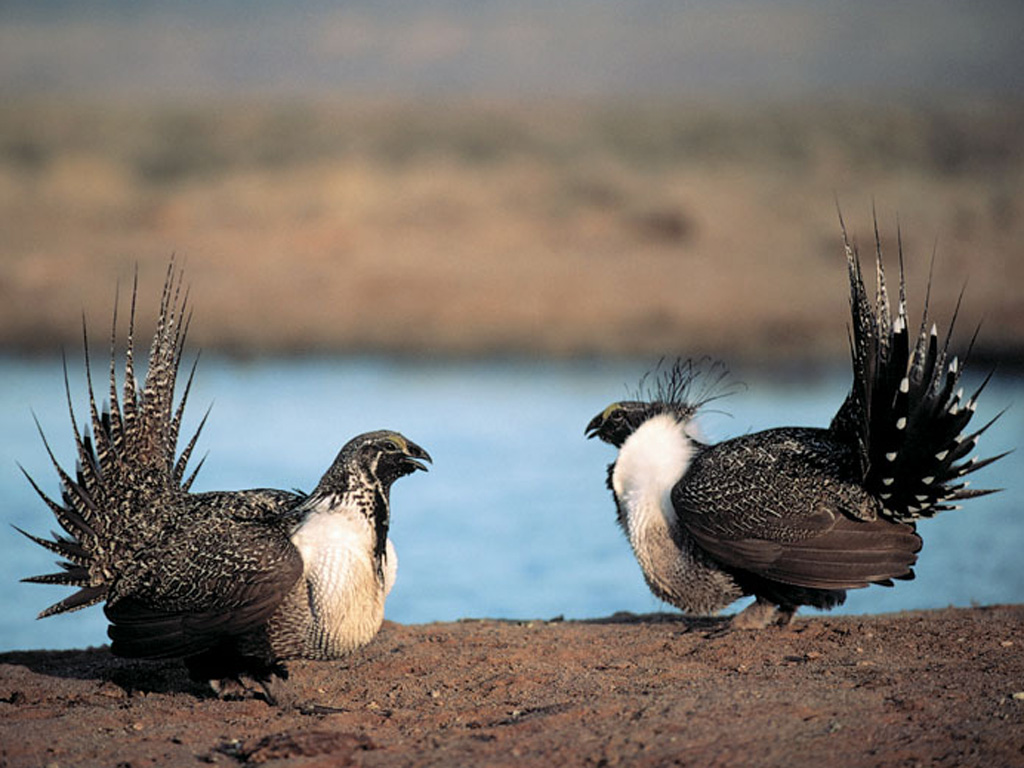

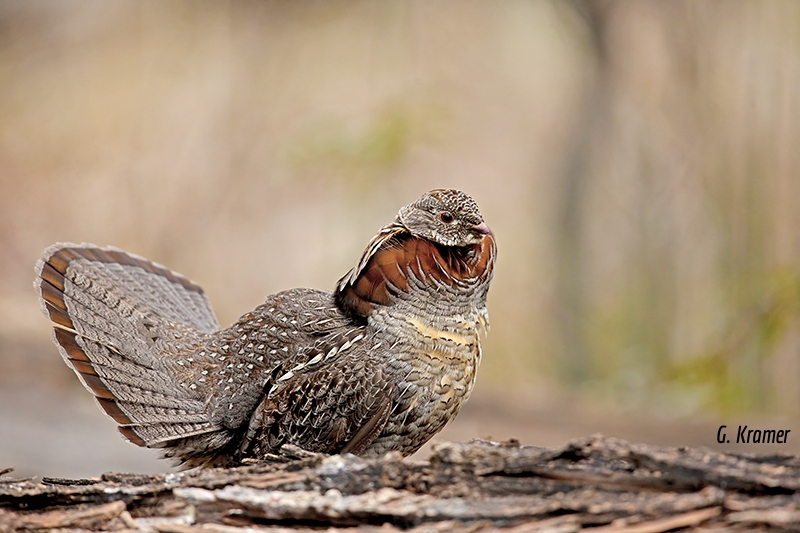
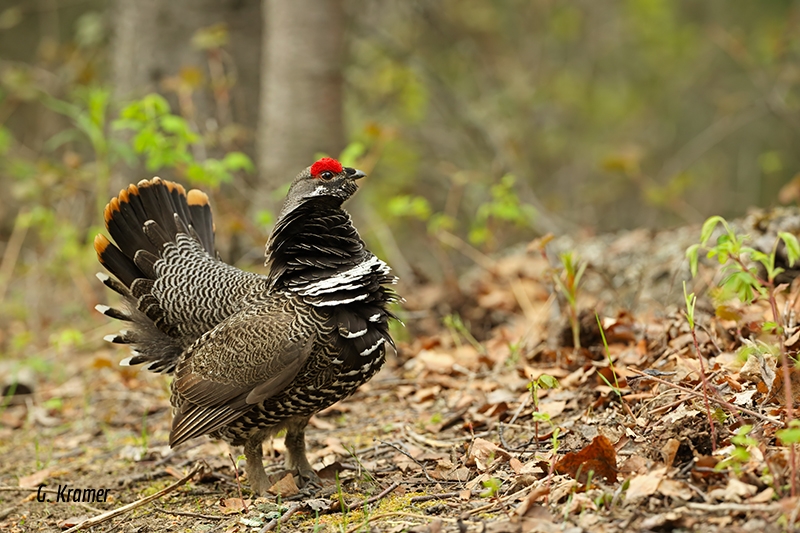
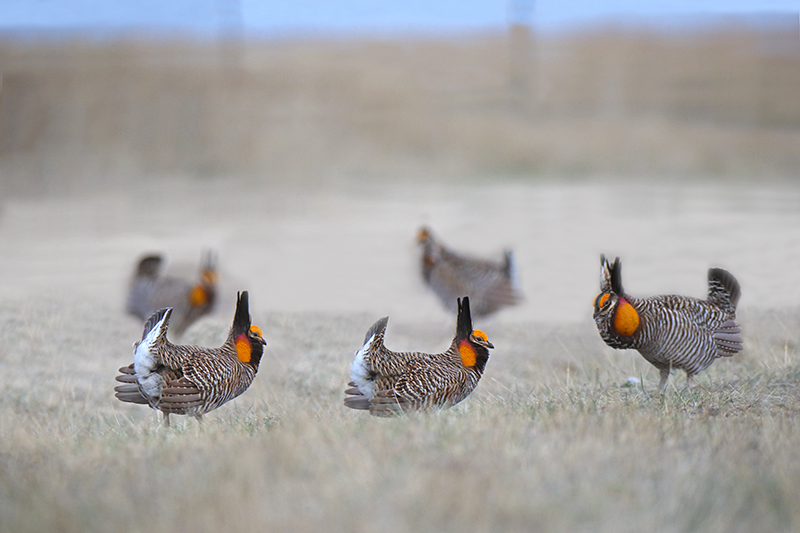
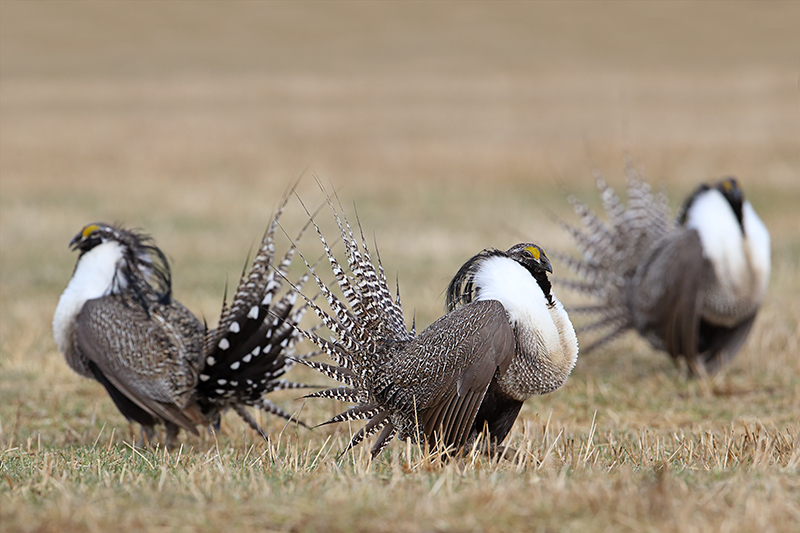

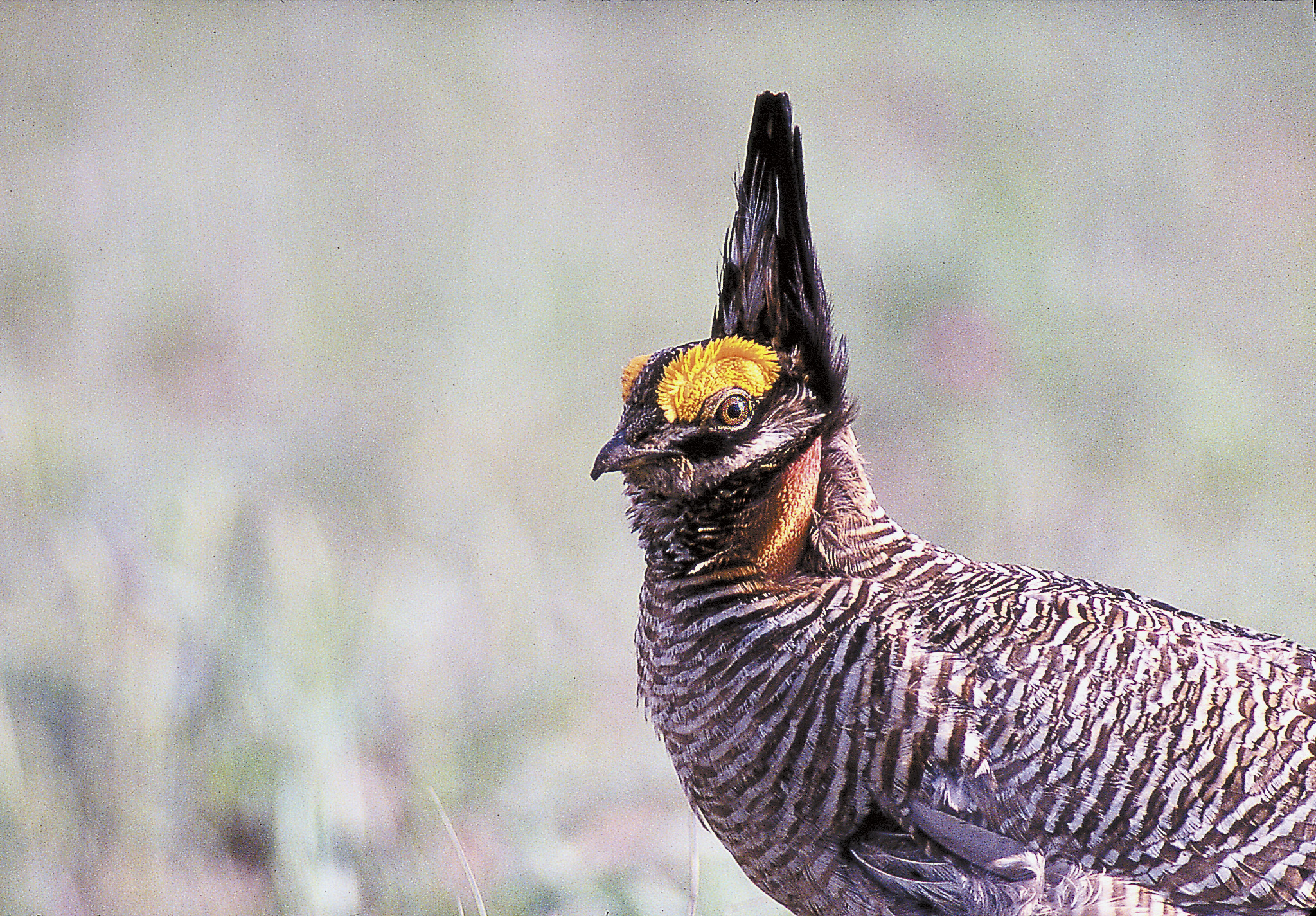
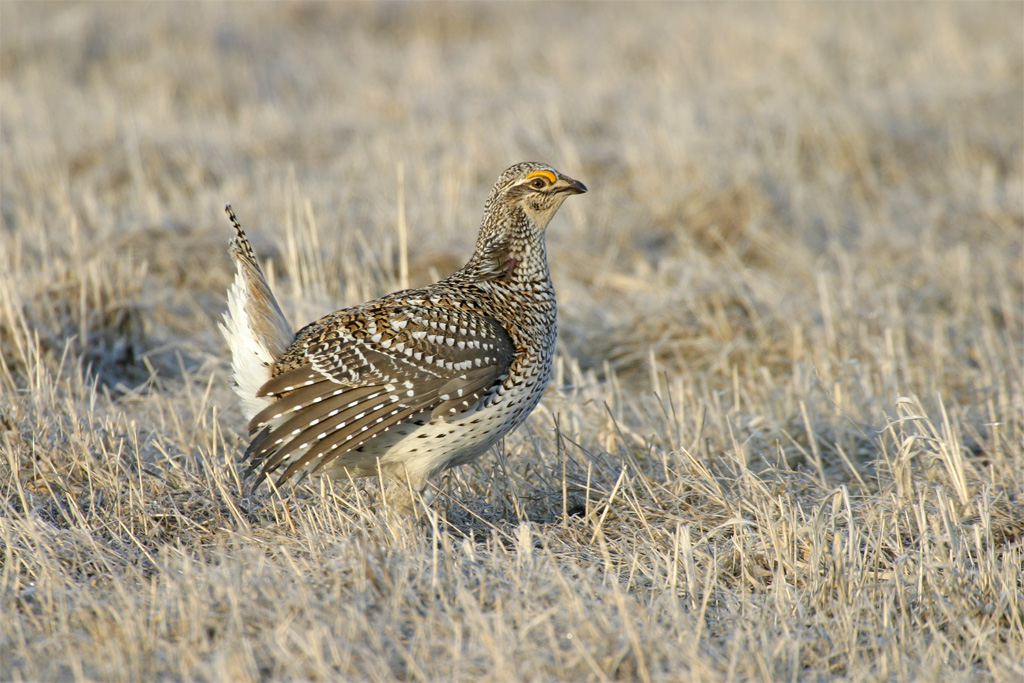

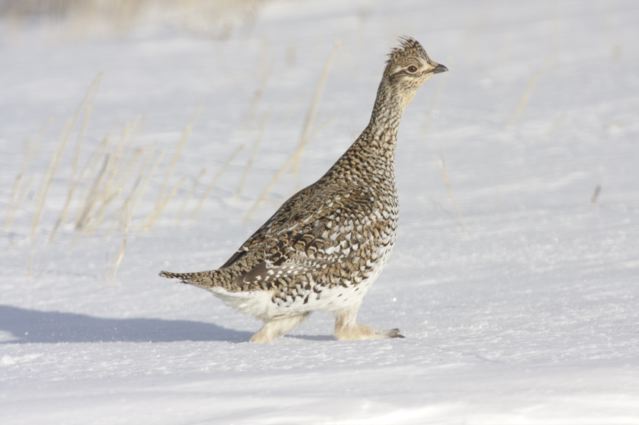
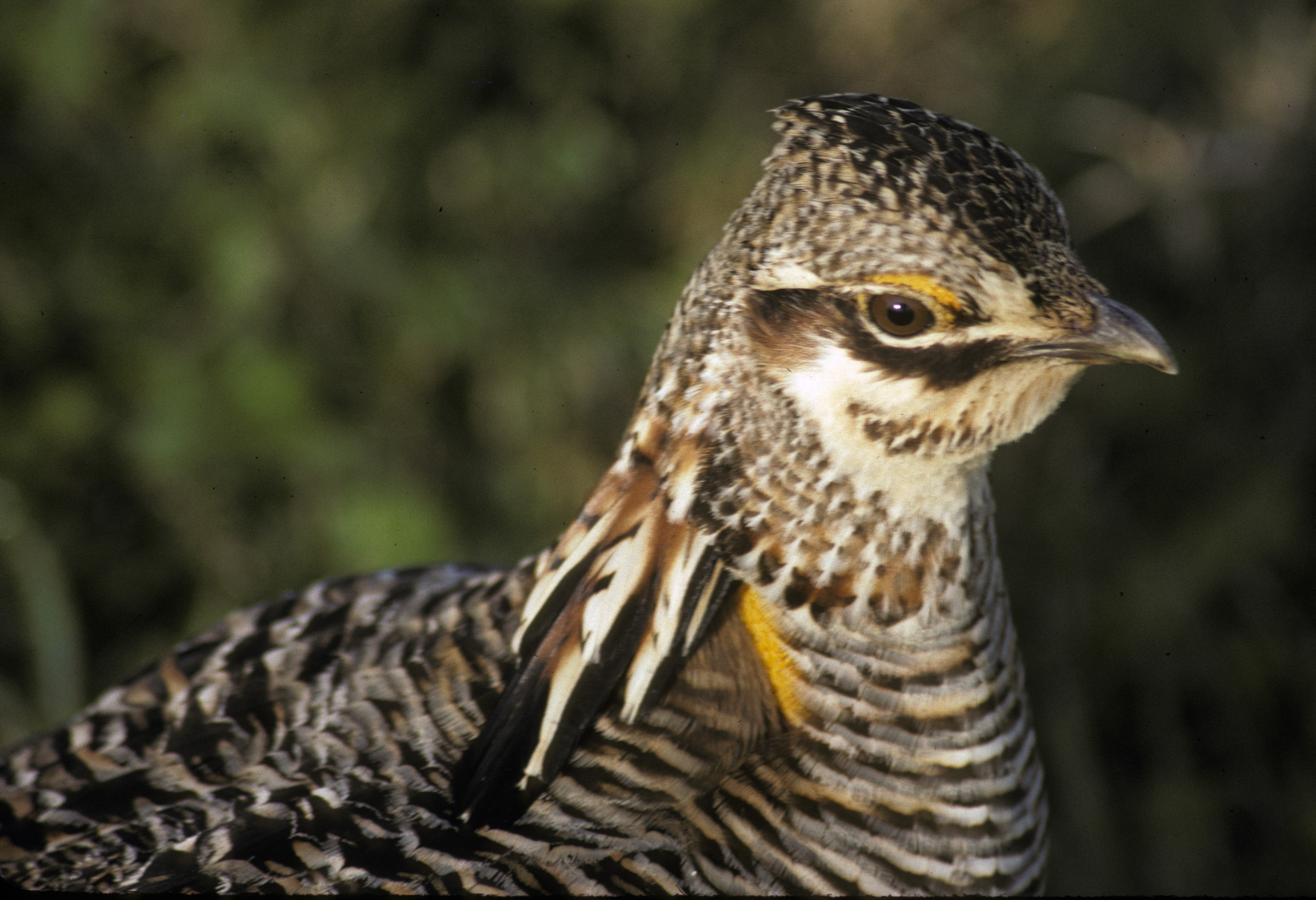
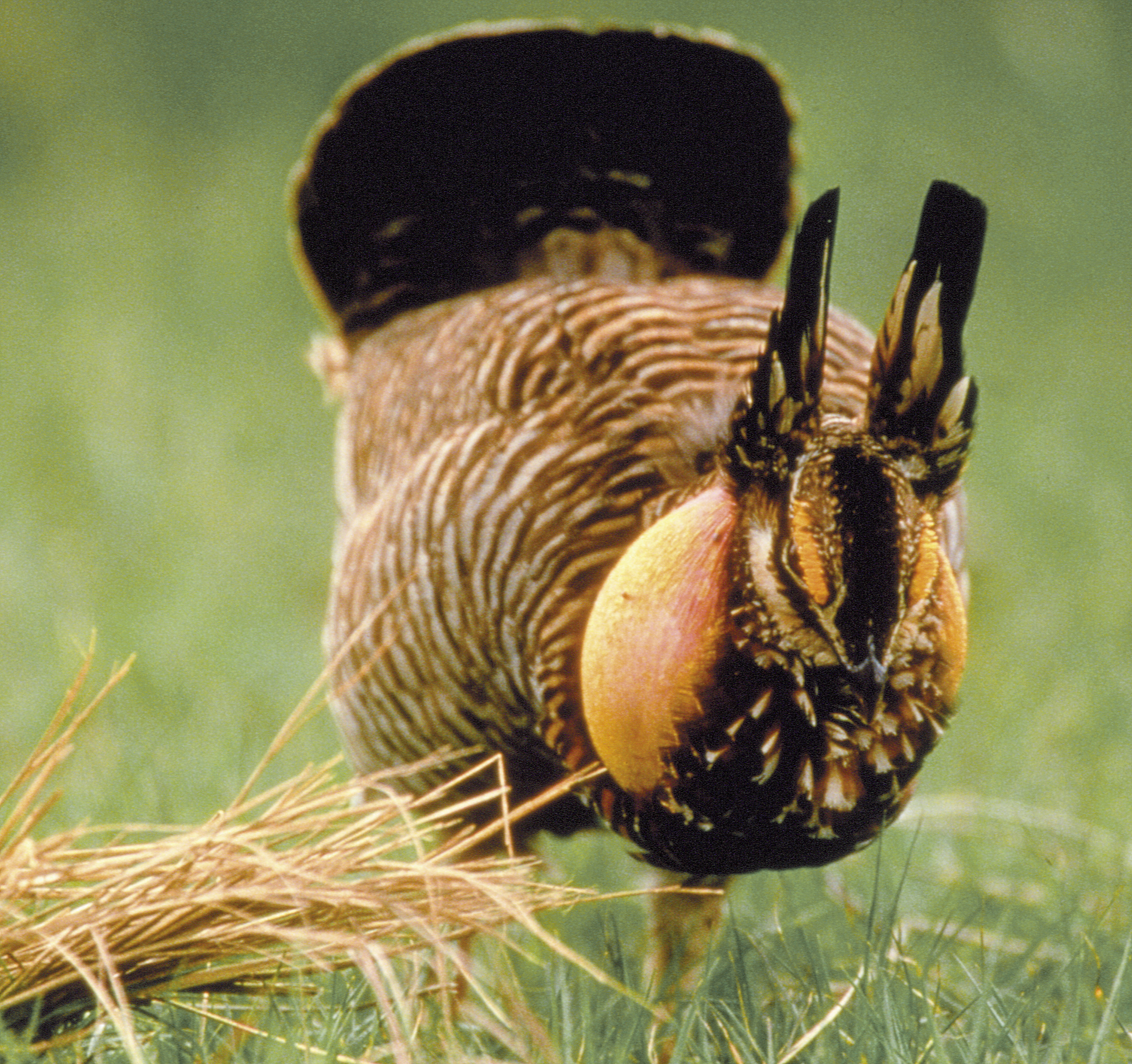
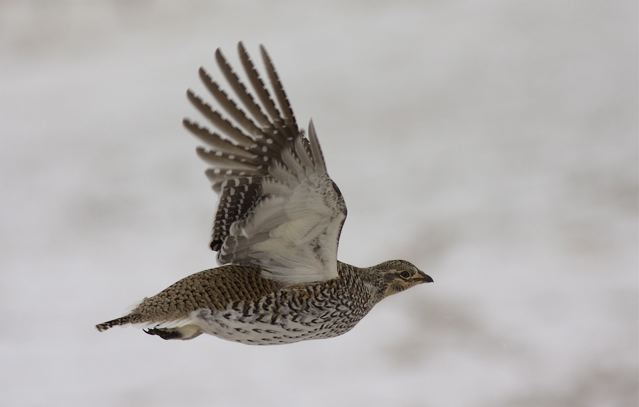
The North American Grouse Partnership (NAGP) is the only conservation organization that advocates for all 12 North American grouse species and their habitats. Our strength is found in Science, Policy, Partnerships, and Management. This is demonstrated by the experience and expertise of our Board of Directors and Council of Scientists and is unparalleled in grouse conservation circles. Our goal is to ensure that grouse conservation is guided by science, public policies are beneficial to grouse and that on-the-ground management of lands lead to positive outcomes for grouse.
WHAT’S NEW? - See Below for the Latest
Settlement Agreement Reached Between Wisconsin Wildlife Federation & Vista Sands Solar Project in Portage County
FOR IMMEDIATE RELEASE
June 30, 2025
Poynette, Wis. – The Wisconsin Wildlife Federation (WiWF) and Vista Sands Solar are pleased to announce a mutual agreement has been reached on the planned solar development in Portage County, Wisconsin. As part of the agreement, and pending formal approval by the Public Service Commission of Wisconsin (PSC), WiWF will be withdrawing its appeal filed in Columbia County Circuit Court.
The agreement comes after several months of collaborative discussions aimed at protecting Wisconsin’s state-threatened Greater Prairie Chicken – while maintaining the full capacity and progress of the renewable energy project. It reflects productive engagement and a shared interest in preserving Wisconsin’s natural heritage, while supporting sustainable homegrown energy generation.
Vice President of Development at Doral Renewables and Project Manager for the Vista Sands Solar project, Jon Baker, said: “From day one, this project has been shaped by a simple, commonsense goal: deliver clean, homegrown energy and economic uplift, while respecting nearby conservation lands, the people who work it, and the wildlife that inhabit it. Thanks to direct feedback from local leaders, adjustments have been made to further protect wildlife habitat and mitigate stakeholders’ concerns – demonstrating that energy progress and environmental stewardship are not at odds.”
“Vista Sands Solar made a tremendous effort to communicate and present accommodations that addressed the concerns raised by our technical working group,” said Cody Kamrowski, Executive Director of the Wisconsin Wildlife Federation. “This agreement shows what’s possible when conservation organizations and energy developers engage, listen to one another, and work toward a shared vision.”
As part of the agreement Vista Sands Solar is building on its existing commitments to restoring nearly 7,000 acres of native grasslands in the region, providing a $2.1 million contribution to support the Wisconsin Department of Natural Resources’ (DNR) Greater Prairie Chicken management plan, and funding for local university-led research to study how wildlife interacts with solar.
Key Elements of the Agreement:
750 additional acres have been set aside specifically to address WiWF’s concerns for the Greater Prairie Chicken.
Vista Sands Solar has committed $1 million to WiWF, specifically designated for habitat restoration and land acquisition in the Greater Prairie Chicken management priority areas.
Project plans remain on schedule and capacity remains intact, ensuring solar-generated electricity will soon benefit Wisconsin homes and businesses.
This settlement is a model for future collaboration between stakeholder groups and energy developers. It sends a powerful message: with good-faith engagement and open dialogue, environmental stewardship and renewable energy goals are not mutually exclusive.
“This agreement sets a strong precedent for public lands and wildlife protections in Wisconsin,” Kamrowski added. “It demonstrates that renewable energy and habitat preservation can – and should – go hand in hand.”
WiWF encourages other conservation and community organizations to engage early with developers on similar projects. Moving forward, WiWF will advocate for the inclusion of stakeholder voices, including the Department of Natural Resources (DNR) advisory committees, during the early stages of project planning and permitting.
The Wisconsin Wildlife Federation looks forward to continued partnerships that protect the state’s rich natural heritage while advancing a clean energy future.
About Vista Sands Solar: The Vista Sands Solar project is a 1.3-gigawatt solar power development in Portage County, Wisconsin, approved by the state’s Public Service Commission. The Vista Sands Solar project is developed by Doral Renewables LLC, a leading renewables company based in Philadelphia. Learn more about the project and the benefits it can bring to the region by visiting vistasandssolar.com.
About the Wisconsin Wildlife Federation: The Wisconsin Wildlife Federation (WiWF) is the state’s largest conservation organization, representing hunters, anglers, trappers, and other outdoor enthusiasts. Since 1949, WiWF has worked to protect and enhance Wisconsin’s natural resources and outdoor heritage through education, advocacy, and conservation leadership. As an affiliate of the National Wildlife Federation, WiWF champions science-based stewardship and policies that sustain wildlife, clean water, and healthy habitats for future generations. Learn more at www.wiwf.org.
###
Media Contacts:
Cody Kamrowski
Executive Director
Wisconsin Wildlife Federation
Phone: 715-896-5445
Email: cody@wiwf.org
Website: www.wiwf.org
Kaden Bosquez
Public Affairs Advisor
Vista Sands Solar Project
Phone: (920) 279-7222
Email: kaden.bosquez@michaelbest.com
Website: vistasandssolar.com
"The chickens will be fine
as long as we can stay in business."
Saving ranching to save lesser prairie-chickens.
May 13, 2025 - Rancher Mark Gardiner recently shared the above reality at an event in Kansas in April to highlight the Lesser Prairie-Chicken Landowner Alliance (LPCLA). The LPCLA of 18 ranchers in Kansas, Oklahoma, Colorado, New Mexico, and Texas banded together three years ago.
Their mission is to save ranching, rural communities, water, and wildlife by seeking to ensure that ranchers are paid fair market value for the multiple conservation services that grasslands and ranching provide to society. These services include clean air and water, and healthy soils, vegetation, and habitat. With 90% of lesser prairie-chicken habitat on private land, ranches are critical to the birds.
During the event, a lek was visited and press conference held. View the videos at the buttons below to hear Ted Koch (NAGP Executive Director), Bret Riley (LPCLA co-lead), Wayne Walker (Common Ground Capitol), and Mark Gardiner, speak about their effort to save ranching.
A Commendation from Kansas' Lt. Governor and Secretary of Commerce was also shared at the event, stating "We honor the Lesser Prairie-Chicken Landowner Alliance for bringing ranchers together to show how conservation practices can be used to sustain and improve our state's world-class grasslands, create new revenue opportunities on their lands, and keep land in production for future generations to carry on their family legacy."
LPCLA ranchers, you are heroes in conservation.
35th Prairie Grouse Technical Council Meeting to be held Sept. 23-25, 2025 at Valentine, Nebraska - Abstracts accepted through June 31.
Mark your calendars for Sept. 23-25 for a meeting of the Prairie Grouse Technical Council (PGTC) in Valentine, Nebraska. After being disrupted by the covid pandemic, the meeting will return to the intended schedule of odd years.
The Council is a group of grouse advocates, enthusiasts, scientists, managers and others who enjoy grouse and their habitats. They meet in the various prairie and great lakes states where these birds are found.
Abstracts for the 35th PGTC meeting are now being accepted through June 31. Authors will be notified about acceptance of their submissions by July 15.
Hotel information is available. Rooms should be booked by August 22.
See the website for abstract and hotel information, and keep an eye on it for registration and program details as they get firmed up. - prairiegrousecouncil.org
For more information, contact Bryan O’Connor at bryan.oconnor@nebraska.gov
Our flock hopes to see you in Valentine next fall!
AN UPDATE FROM NAGP'S EXECUTIVE DIRECTOR
February 26, 2025
NAGP Members and Supporters -
Thank you for your ongoing support of your North American Grouse Partnership (NAGP).
As you may know, grasslands are the most threatened ecosystem on the continent and in the world, and grassland birds in North America have declined by 50% over the last 50 years - twice as much as birds from any other ecosystem. Threats are most acute in the southwestern Great Plains where lesser prairie-chickens were recently listed under the Endangered Species Act (ESA).
Among grassland birds, prairie grouse are the charismatic megafauna and a true umbrella species. Unlike songbirds, prairie grouse require much larger, intact, open landscapes to persist. If you have prairie grouse, you very likely have a lot of other grassland-dependent species. And not just birds, but mule deer, pronghorn, monarch butterflies, and more.
What to do about saving our most threatened ecosystem? Save ranching - the kind of ranching that provides healthy grasslands in addition to beef. Most remaining prairie grouse habitat is on working rangelands. When they go away, so do grouse. Ranching pays less than most other land uses such as energy development, farming, and feedlots. So, as family leaders relinquish control of ranches, the land often gets put to other uses that pay more.
Here are a few facts:
1) U.S. beef production is lower than any point since 1952.
2) Rural communities saw their first decade-long population decline in the 2010s.
3) Over 2 million acres of grasslands are lost in the Great Plains every year.
4) ESA listings in grasslands have begun and are poised to increase.
In partnership with the Lesser Prairie-Chicken Landowner Alliance (LPCLA), we’re seeking to change these trends. A generation ago, ranchers could make a good living raising 400 head of livestock. Now, due to changes in market forces beyond my ability to understand or address, they must find a job in town to help make ends meet.
But we have an opportunity - use Farm Bill Conservation Title program money to provide a second profit center for ranchers in addition to selling beef, keeping them in ranching. In exchange these ranchers want to be held accountable to deliver services to all Americans - measurable, meaningful ecosystem services.
Current Farm Bill programs require price-controlled contracts for implementing practices, usually at a cost to landowners. Instead, NAGP and the LPCLA propose using marked-based, negotiated contracts for specific conservation outcomes. In this way, landowners can negotiate to get paid what they say they need, in a competitive environment, to deliver conservation.
For example, the Playa Lakes Joint Venture (PLJV) uses federal funds to implement a program where they ask all farmers in a county to submit a bid stating what they want to get paid to protect playa lakes on their farm in a specific way. The PLJV then selects the bids that provide the most investment return - the most clean water, the best bird habitat, and other ecosystem services. It’s straightforward, paying what the landowner says they need.
This approach is especially relevant now that federal agencies are losing large portions of their staff because of cuts by the Trump Administration. USDA already struggled to administer their conservation programs. And it’s about to get worse. Federal funding cuts are even impacting non-profits like NAGP and other important conservation organizations. We’ll keep you updated on that impact.
Meanwhile, we hope to see you at Pheasant Fest in Kansas City in just over a week. NAGP will have a booth on the show floor (#2932) and we’re hosting a luncheon on Sunday - please visit our website at grousepartners.org for details and to register.
Please continue to do all you can to continue supporting NAGP’s efforts to provide innovative thinking and leadership, starting with the landowners themselves, to save ranching, grasslands, and prairie grouse.
Thank you,
Ted Koch, Executive Director
North American Grouse Partnership
SOLD OUT -
YOU'RE INVITED TO “A CELEBRATION OF GROUSE AND PRAIRIE” on March 9, 2025 at Pheasant Fest & Quail Classic in Kansas City, MO - Get your ticket below by Feb. 25.
Please join the North American Grouse Partnership (NAGP) and partners for an inspirational luncheon featuring special guest speakers. It will be held on Sunday, March 9, noon to 1:30 pm, at the 2025 National Pheasant Fest & Quail Classic in Kansas City, Missouri. Doors will open at 11:30 am to allow time to visit and check out auction items before the event begins.
This event will raise awareness among upland bird lovers about grouse and generate support to increase NAGP's capacity to meet our mission - the conservation of North America's grouse and their habitats through science, policy, partnerships, and management.
Watch NAGP's website, Facebook, Instagram, and emails for updates. To support grasslands, the luncheon will feature grass-raised beef sandwiches, of course!
Buy your ticket above by Feb. 21. Email jodie@grousepartners.org if you have questions, special dietary needs, and/or are interested in sponsoring the event or providing fundraiser items. A receipt will be emailed to you and serve as your ticket. A list of ticket purchasers will also be available at the door.
We hope you'll join us for fellowship with kindred grouse enthusiasts and to learn how your support can make a vital difference for prairie grouse in North America.
For more information on 2025 National Pheasant Fest & Quail Classic, see https://www.pheasantsforever.org/Pheasant-Fest.aspx Much thanks to PF & QF for the opportunity to host this important event!
WILDLIFE FEDERATION APPEALS PUBLIC SERVICE COMMISSION DECISION ENDANGERING WISCONSIN'S THREATENED GREATER PRAIRIE-CHICKEN POPULATION
Feb. 11, 2025, Wisconsin Wildlife Federation News Release
Contact: Cody Kamrowski, Executive Director, (715) 896-5445
Poynette, Wis: The Wisconsin Wildlife Federation announced today that it was appealing the recent Public Service Commission decision approving the Vista Sands solar project in Portage County. The Federation’s appeal is based on the threat that the project will endanger and possibly extirpate the state-threatened Greater Prairie-chicken population and will significantly reduce the value of the state-owned Buena Vista Wildlife Area in Portage County.
The 7,109.8 acre, 1,315.6 megawatt project will be the second largest solar project in the nation and will be four times larger than any previously approved solar facility in the state of Wisconsin. The concern is that several portions of the project’s solar array fields directly adjoin Buena Vista Wildlife Area grasslands that are used by the Greater Prairie-chickens for nesting and brooding and their leks, areas used by the species for reproduction. Research and professional experience show that when natural or manmade structures are located next to their grasslands and leks, Greater Prairie-chickens (GRPC) avoid and abandon the habitat which will lead to population decline. Greater Prairie-chicken habitat in the state has historically reduced to only three isolated state wildlife areas. The statewide population of the state-threatened species has decreased dramatically over the last fifty years...
Read the full news release with statements from local experts at https://wiwf.org/.../wildlife-federation-appeals-psc...
Donations to help cover legal expenses can be given at https://secure.everyaction.com/DNaX3dm2akqu_6Vvm9o5RQ2
NAGP along with a Coalition of 20 other organizations submitted input to the draft and final Environmental Impact Statements for this proposed solar project.
ATTACKS ON THE ENDANGERED SPECIES ACT PUT IMPERILED SPECIES SUCH AS THE LESSER PRAIRIE-CHICKEN IN JEOPARDY
ACTION ALERT by the American Bird Conservancy shared on Feb. 6 -
Endangered species are under attack, with members of Congress pushing to remove federal Endangered Species Act (ESA) protections for the Lesser Prairie-Chicken — permanently. If enacted, the proposed legislation would likely mean extinction for this iconic species of the Western prairies.
This legislation goes beyond delisting the Lesser Prairie-Chicken — it aims to ensure that the species can never receive ESA protections in the future. These birds have already lost 90% of their grassland habitat, and fewer than 1% of the historic population survive today. While voluntary conservation efforts have helped, independent scientists agree that federal safeguards are essential for the species' survival.
Take Action NOW: Urge your representatives to vote NO on H.R.587, a bill that would eliminate ESA protection for the Lesser Prairie-Chicken and block any future federal protections for this species.
Go to act.abcbirds.org/a/take-action-lesser-prairie-chicken-esa
NINTH CIRCUIT UPHOLDS DECISION IN FAVOR OF GREATER SAGE-GROUSE HABITAT
From the Audubon Press Room, San Francisco, Jan. 17 -
The Ninth Circuit Court of Appeals today upheld a 2020 district court decision that struck down the basis for oil and gas leasing on more than a million acres of public lands that serve as key habitat for the Greater sage-grouse, an iconic bird species of the Western United States.
The court ruled that, under historic plans enacted in 2015, the Bureau of Land Management (BLM) is mandated to prioritize leasing outside of essential sage-grouse habitat. The 2015 plans specifically require “affirmative action by the agency to promote and encourage leasing outside of sage-grouse habitat,” and necessitate “independent agency determinations of which parcels to offer for oil and gas leases.” Today’s decision affirms the district court’s invalidation of 158 oil and gas leases located in vital habitat areas, leases that violated the BLM’s requirements.
“Sound public lands management is critical to halting the decline of the Greater Sage-grouse, a bird that is tied to the health of sagebrush country itself,” said Alison Holloran, executive director of Audubon Rockies and vice president of National Audubon Society. “With the collective interest in good management and conservation, this decision from the court underscores that the Bureau of Land Management must consider sage-grouse habitat when leasing for oil and gas development on public lands. Thoughtful siting of development and on-the-ground efforts are key to ensuring that we have healthy public lands to pass down to future generations.”
Recent studies show that the grouse has declined 80 percent across its range since 1965. An estimated 1.3 million acres of functional sagebrush ecosystem are lost to climate change and development every year.
Contact: Jason Howe, jason.howe@audubon.org; 415-595-9245
Greater Sage-Grouse Scientists Submit Letter to DOI Regarding BLM’s Final EIS
Dec. 12 , 2024 - A group of greater sage-grouse scientists, including several with the North American Grouse Partnership, submitted a letter to the Department of Interior (DOI) today regarding Bureau of Land Management’s (BLM) Sage-Grouse Final Environmental Impact Statement (EIS).
In a June letter to BLM, scientists articulated support for planning outcomes that effectively conserve sage-steppe habitat based on the best available science. They observed that BLM’s Sage-Grouse Draft EIS is an important step forward from the agency’s earlier effort in 2019. However, they also cautioned that there were still a variety of science-based refinements that should be included in the final decision.
Today’s letter states - ”BLM released its proposed plans in November 2024. By strengthening some of the provisions proposed in the draft plans, the proposed action largely embraces the best available science and thus would be significantly more effective in conserving sage-grouse and sagebrush habitats than the agency’s 2019 plans. Moreover, the preferred action in the 2024 Final EIS appears to meet a science threshold that the more development-oriented alternatives do not. The stepped-up protections in the proposed action's Priority Habitat Management Areas are consistent with the best available science. As scientists have observed in prior correspondences, the conservation of greater sage-grouse is best served by state and federal agencies fully cooperating and sharing data and using best available science to guide management actions.
We strongly encourage you to direct federal planners to finalize conservation plans that prescribe objective, measurable and robust conservation measures based on the best available science across the species’ range.”
Read the full letter by clicking the button below.
Interior Department Proposes Strengthened Protections for Greater Sage-Grouse Habitat
Proposed management updates employ science and partnership to balance development and conservation
WASHINGTON, Nov. 8, 2024 — The Department of the Interior announced today that the Bureau of Land Management (BLM) has published proposed updates to strengthen conservation and management of greater sage-grouse habitat on public lands, informed by the best available science, collaborative work with states, and input from local, Tribal and federal partners. The proposed updates, outlined in a final environmental impact statement and amendments to 77 resource management plans, incorporate new sage-grouse conservation science and lessons learned and accommodate changing resource conditions while increasing implementation flexibility. The proposals balance a consistent west-wide management approach with unique policies in the individual states that are responsible for managing wildlife populations.
Updated habitat management plans will protect greater sage-grouse habitat in 10 Western states. Sage-grouse populations have continued to decline, largely due to habitat loss exacerbated by climate impacts such as drought, increasingly intense wildfires, and invasive species. Conserving sagebrush habitat benefits more than 350 other wildlife species and supports the livelihoods and traditions of Western communities. Species like elk, mule deer, pronghorn and pygmy rabbit rely on the same habitat to survive, and sagebrush lands contain headwaters for some of the West’s major river systems and the aquatic species they sustain.
“Guided by the best available science, we are committed to the continued balance in our multi-use mandate for America’s public lands,” said Secretary Deb Haaland. “For too long, a false choice has been presented for land management that aims to pit development against conservation. This Administration’s collaborative work has demonstrated that we can do both successfully. Through collaborative work in local communities, developed over decades, we are presenting science-based and thoughtful proposals to protect the greater sage-grouse and its habitat.”
The BLM manages the largest single share of greater sage-grouse habitat in the United States—nearly 65 million acres of 145 million total acres. The proposal released today builds on a number of collaborative efforts undertaken by the Biden-Harris administration – including the Public Lands Rule, renewable energy rule, and the proposed Western Solar Plan – to strengthen protection for sagebrush habitat while retaining flexibility to coordinate with state government partners and account for variations in local habitat conditions. Today’s proposal will help ensure that other uses of BLM sagebrush lands, including clean energy projects, move forward in a manner that limits impacts to sensitive resources and can also help combat climate change—a main driver of greater sage-grouse habitat loss.
“This remarkable species and the people who live, work, and play alongside it deserve management that will sustain sagebrush habitat across the West for years to come,” said BLM Director Tracy Stone-Manning. “Our environmental analysis, aided by a wealth of information from our partners, indicates that these proposed updates—which are the result of decades of sustained collaborative efforts—are the best way to ensure the health of these lands and local economies now and into the future.”
The BLM considered roughly 38,000 comments from the public on the draft environmental analysis, along with information shared by state, local, Tribal and federal partners during more than 100 meetings held over two years. States also contributed data and scientific information that helped frame direction on adaptive management and mitigation requirements and supported updates to the boundaries of habitat management areas. The BLM engaged in government-to-government consultation and held informational briefings for Tribal governments throughout the process. Planning documents are available for review at the BLM National NEPA Register.
Protests of the proposed amendments may be filed until Dec. 9, 2024, at the BLM Filing a Plan Protest page. Following resolution of valid protests and responses to governors’ reviews for consistency with state and local plans, the BLM will issue Records of Decision for each state where habitat management plans are being updated.
In addition to management decisions guided by the habitat plans, the BLM is actively restoring and conserving sagebrush habitat across the West through the President’s Investing in America agenda. For example, as part of the Department’s new Sagebrush Keystone Initiative, the Department has identified “Sagebrush Collaborative Restoration Landscapes” as areas to collaborate with ranchers, state and local leaders, Tribal Nations, conservation and sportsmen organizations, the outdoor recreation economy, private landowners and others to strategically deliver restoration actions in sagebrush country for the people, wildlife, and economies that depend on them. The Department’s National Seed Strategy Keystone Initiative is also devoting resources to ensure a ready source of native plant seeds to further enhance landscape resilience and has identified five areas of greater sage-grouse range in which to fund habitat restoration and conservation.
Contact: Interior_Press@ios.doi.gov
U.S. HOUSE INTRODUCES NORTH AMERICAN GRASSLANDS CONSERVATION ACT The time to protect America’s grasslands and shrub-steppe ecosystems is NOW.
Oct. 18, 2024 - Last week, the North American Grasslands Conservation Act was introduced in the House of Representatives by U.S. Representatives Nancy Mace (R – S.C.), Sharice Davids (D – Kan.), Brian Fitzpatrick (R – Penn.) and Mike Thompson (D – Calif.). Once passed, the legislation will be one of the most significant steps for grassland conservation efforts in the 21st century.
More than 70 percent of America’s tallgrass, mixed grass, and shortgrass prairies have vanished, followed by the precipitous decline of grassland bird populations – more than 40 percent since 1966. Additionally, grazing lands that have sustained generations of ranchers are dwindling and species from sage grouse and pheasants to monarch butterflies and elk to are struggling to navigate landscapes they used to call home.
The Grasslands Act would kickstart the voluntary protection and restoration of grasslands and sagebrush shrub-steppe ecosystems – and the livelihoods and wildlife dependent upon them. Functionally, the legislation is modeled after the successful North American Wetlands Conservation Act (NAWCA) and would create a landowner-driven, voluntary, incentive-based program to conserve America’s critically imperiled grasslands. There’s urgency to maintain these grassland biomes for agriculture, wildlife habitat, carbon sequestration and for future generations while supporting ranchers, farmers, Tribal Nations, sportsmen and women and rural communities.
The concept of a Grasslands Act was first introduced in the U.S. Senate during the 117th Congress, led by Senators Ron Wyden (D-Ore.), Amy Klobuchar (D-Minn.) and Michael Bennet (D-Colo.). This new U.S. House version has some key changes aligning it more closely with NAWCA, improving tribal provisions, and making it more bipartisan.
“We need the Grasslands Act now", stated Ted Koch, North American Grouse Partnership (NAGP) Executive Director. "Grasslands are the most threatened ecosystem in America, and of the nine prairie grouse populations found historically, six are either extinct or recognized under the Endangered Species Act, and the other three are declining.”
“The United States has over 125 million acres of grasslands that are threatened, and right here in South Carolina, we see firsthand how important conservation is to the health and beauty of our natural ecosystems,” Mace said. “Our office has made a promise to preserve this beauty, not just for today but for future generations.”
“In Kansas, we have grassland prairies that are well known throughout the Great Plains for their beautiful landscapes and scenic hiking trails, but grasslands once covered millions of acres across North America, stretching from coast to coast,” Davids said. “Grasslands are vital to ranchers and producers, Tribes, and folks who love spending time outdoors. They’re critical habitat for countless species of birds, important pollinators, and treasured animals like the bison. And, they’re crucial to fighting the effects of climate change, bolstering our food security, and combatting extreme weather. I’m excited for this opportunity to highlight the protection of our grasslands and bipartisan solutions that build off of successful public-private partnerships.”
“Grasslands are vital to the livelihoods of our nation’s ranchers and the health of our native wildlife — yet they remain endangered. It’s great to join my colleagues to introduce the bipartisan North American Grasslands Conservation Act to invest in voluntary, incentive-based programs to help farmers, ranchers, Tribal Nations, sportsmen and women, and state and local governments preserve, rehabilitate, and responsibly manage our grasslands for generations to come,” Thompson said.
“Grasslands are among the most endangered ecosystems in the world, with over 70 percent of America’s tallgrass, mixed grass, and shortgrass prairies now gone,” Fitzpatrick said. “Our grasslands are vital for the survival of farmers and rural communities across Pennsylvania and our nation, which is why I am championing this critical piece of bipartisan, bicameral legislation. By establishing a landowner-driven, incentive-based program and investing in restoration programs, the North American Grasslands Conservation Act will protect essential habitats that support our American farmers, ranchers, and Tribal Nations and revitalize these critical ecosystems, ensuring they continue to sustain wildlife and rural communities for generations to come.”
More than 45 organizations, including NAGP, are collaborating in support of the Grasslands Act. A full roster of those groups can be found at www.ActforGrasslands.org. Additionally, the Cornell Lab of Ornithology has partnered with the coalition to develop the www.MapForGrasslands.org website, which provides a powerful tool to visualize the loss of grasslands habitat.
GRASSLANDS ARE THE MOST THREATENED ECOSYSTEM IN THE WORLD - Lesser Prairie-Chickens are Exhibit A
An op-ed in the Odessa American on-line news;, September 24, 2024
By Ted Koch, Executive Director, North American Grouse Partnership
The grassland-dependent lesser prairie-chicken was recently listed under the Endangered Species Act. Why? Because the purpose of the Act is to conserve the ecosystems upon which we and all other species depend. Grasslands, including sand sagebrush and shortgrass prairie, are the most threatened ecosystem on the continent and in the world, especially here in Texas and the southwestern Great Plains.
In fact, over the last 50 years grassland birds overall have declined more than birds in any other ecosystem on the continent. And as the recent listing under the Act shows, lesser prairie-chickens in our region are, unfortunately, leading that decline. And if it wasn’t these charismatic chickens, there would soon be another species listed here.
The North American Grouse Partnership (NAGP) believes we must all pull together now to save grasslands and chickens and avoid the need to list any more species.
We thought we had a good road map: the Western Association of Fish and Wildlife Agencies’ (WAFWA’s) Range-Wide Plan. Unfortunately, developed 10 years ago, it now sits without funding or leadership to implement it. For example, by now the plan called for restoring 1 million acres of habitat; we’re perhaps just 2% of the way there. In that same timeframe we’ve lost hundreds of thousands of more acres of habitat which is a big net loss for chickens.
Meanwhile, WAFWA supported a recent university study that found genetic differences within lesser prairie-chicken populations, and between them and their close cousin, the greater prairie-chicken, with whom lessers sometimes hybridize. The scientists did not say how to apply their scientific findings to the legal decision on how to treat the listed chickens under the Act; be it as a species, or a subspecies, or as two or more distinct population segments, all of which are allowable.
Somehow, WAFWA now claims the findings call the entire decision whether to list into question. Of course, another group could rightfully claim the opposite – that the findings support the way the listing decision was made. Also, case law under the Act regarding hybridization has been addressed with other species before, and there’s little difference, in fact, this time around.
But most importantly, who cares? The grassland ecosystem in our backyard, upon which we and so much other wildlife depend, is clearly among the most endangered in the world. Let’s focus on that. We urge the five lesser prairie-chicken states to reestablish their leadership of the Range-Wide Plan and save them in our backyard. The states could also join the NAGP in our ground-breaking work collaborating with local ranchers and private landowners to save ranching and chickens, creating win-win solutions that keep people and wildlife on the ground together.
Let us not be distracted by arcane scientific arguments over whether certain birds are cousins or step-siblings. Instead, let’s save our most endangered ecosystem while there’s still a little time left.
Ted Koch spent 30 years working as an Endangered Species Biologist for the U.S. Fish & Wildlife Service throughout the West.
LESSER PRAIRIE-CHICKEN TO BENEFIT FROM CONSERVATION RESERVE PROGRAM MEASURES
The following is excerpted from USDA Farm Service Agency (FSA) Notice CRP-1034 on Sept. 9, 2024. NAGP and the Lesser Prairie-Chicken Landowner Alliance have been working with partners and agencies to support measures such as these to benefit lesser prairie-chicken.
On November 17, 2022, the USFWS listed the lesser prairie-chicken under the Endangered Species Act. On March 27, 2023, the listing became effective. USFWS concluded that Conservation Reserve Program (CRP) implementation is anticipated to result in a long-term positive population response.
Thus a notice was shared to inform State and County Offices of conservation measures and restrictions on permissive uses of CRP land across portions of southeastern Colorado, western Kansas, eastern New Mexico, western Oklahoma, and portion of Texas (see map), providing habitat and hosting remaining lesser prairie chicken populations; and to facilitate agricultural producer and landowner outreach and awareness about the new conservation measures.
Counties designated as “core” counties will prescribe conservation measures in the conservation planning process. Conservation measures include CRP practices and NRCS technical practices and applies to all CRP signup types including grassland, continuous, and general when the offer is in a “core” county.
The measures are designed to:
• avoid or minimize potential adverse effects to lesser prairie chicken and other federally listed species, and
• encourage establishment of large blocks of quality habitat comprised primarily of diverse native species, adapted to local ecological site descriptions, providing appropriate food, cover and other habitat needs throughout the year, including breeding, nesting, brood-rearing, winter cover, and protection against predators.
CRP maintenance and management activities are restricted to avoid or minimize disturbance of breeding, nesting, and brood-rearing activities during primary nesting and brood-rearing seasons.
A critical reproduction period of March 1 through July 15 is established. These dates are crucial in nest success and survival of chicks as the first breeding season has been identified as a key parameter affecting lesser prairie-chicken population growth rates.
Specific conservation measures for each conservation practice standard are identified for prescribed fire, forage harvest management, and livestock pipeline.
Read the full USDA Notice at https://www.fsa.usda.gov/Internet/FSA_Notice/crp_1034.pdf...
USDA announced on Sept. 20 that it is accepting offers for more than 2.2 million acres from agricultural producers and private landowners through this year’s Grassland, General, and Continuous CRP signups. With these accepted acres, enrollment is very near the 27 million CRP acreage cap. Including the nearly 1.44 million acres recently accepted in Grassland CRP for offers received in 2024, producers will have enrolled more than 10 million acres in this popular working-lands program. Nearly 200,000 acres have also been accepted through the General signup, bringing total acres enrolled in General CRP to 7.9 million acres.
RECENT SAGE-GROUSE NEWS - Ongoing plight but an increase in Wyoming lek attendance
Click below to read an op-ed about the ongoing plight of sage-grouse and need for an effective BLM plan. Plus news that the Wyoming Game and Fish Department reported a 33% increase in sage-grouse lek attendance this spring compared to last year. This marks a positive shift in the sage-grouse population, which follows the natural cycles the species experiences. Favorable moisture conditions this year also contributed to the improved sagebrush habitat, which is critical to sage-grouse survival. Last year’s counts were affected by harsh winter conditions.
American Wildlife Conservation Partners Release Conservation Policy Recommendations in "Wildlife for the 21st Century", 7th edition
On September 11, the American Wildlife Conservation Partners (AWCP) released Wildlife for the 21st Century, Volume VII (W-21). This comprehensive publication focuses on solutions to conserve wildlife and their habitats across the nation, bolstering public access, and protecting our outdoor traditions.
The recommendations in W-21 will aid policymakers in the next Administration and the next two Congresses in making decisions on sporting-conservation issues and practices that are vital to current and future generations of sportsmen and sportswomen and other conservationists.
The North American Grouse Partnership is part of AWCP, which is made up of the nation’s top 52 sporting-conservation organizations that represent America’s hunter-conservationists, professional wildlife and natural resource managers, outdoor recreation users, conservation educators, and wildlife scientists.
AUGUST 2024 UPDATE
NAGP & 20 PARTNERS SUBMIT LETTER REGARDING FINAL EIS on Proposed, Massive Solar Farm Adjacent to Last Wisconsin Prairie-Chicken Stronghold
NAGP and 20 partners submitted a letter on August 15, 2024 with recommendations regarding the final EIS for the proposed Vista Sands Solar Project in central Wisconsin. The letter can be found at the button below, and more detail on the project read in the below June post regarding the draft EIS. The final decision on the proposed project now rests with three Public Service Commissioners, who must make a ruling by January 2025.
An opinion piece by Peter Ziegler, past president of the Society of Tympanuchus Cupido Pinnatus (Greater Prairie Chicken Society), in the Milwaukee Journal Sentinel on Nov. 16, 2024 regarding the proposed project can also be found below.
SPORT A SHARP-TAILED GROUSE SHIRT & SUPPORT NAGP!
Project Upland has teamed up with the North American Grouse Partnership through their new Bird Shirts for Birds Program to commit $10 per sharp-tailed grouse shirt. This is an ongoing donation to NAGP through the end of the year.
Project Upland created this program to raise money for non-profits in the upland hunting space, and also has associated shirts for Chukar Chasers Foundation and Ruffed Grouse Society. Their hope is to add more designs and organizations in the future.
Buy your favorite upland apparel and give back simultaneously! Magazine subscribers get $5 off.
Thank you, Project Upland!
NAGP & 19 PARTNERS SUBMIT LETTER REGARDING DRAFT EIS on Proposed, Massive Solar Farm Adjacent to Last Wisconsin Prairie-Chicken Stronghold
June 14, 2024 - NAGP is immensely grateful to all who who submitted comments on the Draft Environmental Impact Statement for the proposed Vista Sands Solar project in central Wisconsin, and/or signed on to a coalition letter, to the Wisconsin Public Service Commission and Wisconsin DNR. At the below button, find the letter with a list of all 19 partners that signed on. Please thank and support these organizations!
A solar electric generation facility and associated facilities are proposed on approximately 6,737 acres, with 3,012 acres as alternative acres, along the northern and western portions of the Buena Vista Wildlife Area. This Area harbors the largest concentration of greater prairie-chicken (GRPC) among the four remaining wildlife areas in Wisconsin which they inhabit.
This project as proposed will have significant detrimental impacts on the last remaining core habitat and GRPC in Wisconsin. And a cumulative impact on GRPC within its overall range, increasing potential for its continued decline and need for federal protections under the Endangered Species Act. In addition, the local economy, recreation, and outreach/education will be negatively affected if the population declines to the point that activities such as viewing blinds and the Prairie Chicken Festival cannot continue.
NAGP and partner recommendations included first and foremost that an alternative site be found in an intensively altered landscape that is not adjacent to critical wildlife habitat. We also recommend mitigation of a one-mile buffer, design features that minimize impacts to GRPC, establishment and management of native vegetation beneath and around solar arrays, and use of compensatory offsets such as a habitat bank. Finally, we recommended examining impacts of a federal listing of GRPC, use of current data and the best available science, funding of an independent research study to monitor impacts, and adaptive management.
Local Wisconsin partners are now preparing for hearings.
NAGP Job Announcement - Lesser Prairie-Chicken Landowner Alliance Coordinator, Apply by July 29
NAGP is seeking an individual committed to conserving North America’s Lesser Prairie Chicken and the grasslands they inhabit through an innovative partnership with ranching landowners and operators in the southwestern Great Plains. The successful candidate will serve as the primary point-of-contact with landowners and coordinate implementation of an exciting new program. Apply by July 29. Click below for details.
NAGP Welcomes New Board Member, Jordan Martincich
The North American Grouse Partnership (NAGP) is proud to announce that Jordan Martincich has joined its Board of Directors. Jordan is a passionate upland bird hunter and prairie grouse lover with significant conservation sector leadership experience. He is member of the Pheasants Forever and Quail Forever’s team where he serves as the organization’s Vice President of Development.
“It’s an honor to join the NAGP Board of Directors. NAGP is a small but mighty organization that has been punching above its weight for many years. I look forward to helping NAGP expand its reach for the benefit of grouse, the ranching community, and future generations,” said Jordan.
”We are very excited to have Jordan on our Board” said NAGP President Jon Haufler. “His background in development combined with his passion for grouse provide a tremendous resource for our organization.”
Jordan will help grow NAGP from its status as an emerging player in wildlife conservation to become a leader in prairie grouse conservation across North America. This growth comes at a time when prairies are recognized as the most threatened ecosystem type on the continent and lesser prairie-chickens in the southwestern Great Plains were recently listed under the Endangered Species Act.
Our work could not be more urgent,” said Ted Koch, Executive Director of NAGP. “We’re excited to have Jordan’s strength and energy behind us.”
Greater Sage-Grouse Scientists Submit Letter to BLM Regarding Draft EIS - Submit Your Input by June 13
June 3, 2024 - A group of greater sage-grouse scientists have submitted input to the Bureau of Land Management (BLM) regarding the 2024 Greater Sage Grouse Draft Environmental Impact Statement (EIS) that will result in amendments to 76 resource management plans across the 67 million acres of habitat managed by the agency. Sage-grouse populations have continued to decline during the last decade, and recent science supports BLM developing new plans to allow decisive action across state boundaries to accomplish lasting benefits for sage-grouse and sagebrush habitat.
The scientists support planning outcomes that effectively conserve sage-steppe habitat based on the best available science, believe the BLM’s sage grouse EIS is an important step forward from the agency’s earlier effort in 2019, and state there are still a variety of science-based refinements that should be included in the final decision to advance BLM’s responsible land stewardship. These refinements involve habitat connectivity, “no net loss” of sagebrush habitats, lek buffers, a targeted annual warning system, and grazing.
The letter states “The sagebrush biome is at the critical juncture with its fate of whether or not it continues to be a functional ecosystem hanging in the balance. Active management is critical and the time to arrest the decline of the system is short. It bears repeating that we're experiencing a sustained loss of high quality sagebrush of about 1.3 million acres per year. We have to slow the loss of quality sagebrush and at the same time move compromised habitat into a high quality category. We encourage aggressive action to meet this challenge.”
Read the full letter by clicking the button below.
Submit your input by June 13 using the second button below.
35th Prairie Grouse Technical Council Meeting to be held in Nebraska in fall 2025.
This timing will allow for this important gathering of grouse scientists and enthusiasts to return to the intended schedule of odd years after being disrupted by the covid pandemic.
2024 Joint Meeting of the MN Prairie Chicken Society and MN Sharp-tailed Grouse Society
Presentations Are Now Available!
ADVOCATES FOR GRASSLAND ACT WELCOME NEW CONSERVATION TOOL
Science-based project demonstrates the need for legislation aimed at conserving America’s prairies, savannas, glades, and sagebrush.
Washington, D.C. – April 11, 2024 – Today, a coalition of conservation organizations is celebrating the launch of MapforGrasslands.Org as illustration of the need for the North American Grasslands Conservation Act. The first-of-its-kind website documents the loss of grasslands in North America, the subsequent impact on iconic wildlife species, and the need for grasslands-specific legislation – the North American Grasslands Conservation Act (Grasslands Act) – to address upland habitat loss.
The new website demonstrates the significant loss of America’s prairies, savannas, glades and sagebrush over a thirty-year period (1992-present). Fifteen individual species are also highlighted within the project, showcasing population declines in some of America’s iconic wildlife — including the greater prairie-chicken, greater sage-grouse, monarch butterfly, and bobolink. Produced by Cornell Lab of Ornithology in collaboration with the coalition, the project is a valuable tool for legislators, hunters, and conservationists to better understand the habitat and species loss in their own backyards while empowering individuals to act.
“Grasslands across the U.S., and the species that call them home, are suffering dramatic losses. To deliver the message of grasslands in trouble and inspire action, we saw the need to show in one place all these losses, using the most authoritative evidence available,” said Wenfei Tong, a Science Editor at the Cornell Lab of Ornithology. “The value of this tool is that it summarizes published data to show the link between large-scale biodiversity declines and the loss of our native grasslands.”
“The Map for Grasslands tool really demonstrates the magnitude of grasslands habitat loss across the country and how those lost ecosystems have had devasting impacts on the birds, insects, mammals, and even the fish species living there,” stated Pheasants Forever and Quail Forever President & CEO Marilyn Vetter. “It’s a great example of how science can help make the case for critically important Grasslands Act legislation.”
“It’s hard to imagine the massive loss of grasslands across our enormous prairie ecosystems, but with Map for Grasslands, now we can see it,” said Ted Koch, Executive Director for the North American Grouse Partnership. “Over two centuries we went from unending ‘seas of grass’ with teeming wildlife like prairie grouse, to postage-stamp grasslands and increasingly endangered species. Americans have saved other endangered ecosystems before. Now it’s time to save prairies with the North American Grasslands Conservation Act.”
“Grasslands are North America’s most imperiled ecosystem. This mapping tool affirms that we need to take concerted, collaborative steps to conserve and restore this landscape, which is essential for wildlife, water, and our way of life throughout the country,” said Aviva Glaser, Senior Director of Agriculture Policy at the National Wildlife Federation. “We need our leaders to rally around solutions like the North American Grasslands Conservation Act to ensure this great American landscape endures for future generations.”
“With more than 1.5 million acres of vital grassland habitat being lost to the plow each year, we’re trending in the wrong direction. The Map for Grasslands tool clearly illustrates how the current rate of grasslands destruction not only harms wildlife, but our own health and well-being too,” said Martha Kauffman, Vice President for the Northern Great Plains Program, World Wildlife Fund-US.
“All wildlife rely on healthy habitat to thrive – from grasslands to forests – and arming landowners with the resources to conserve and manage habitat is vital for wildlife,” said Ben Jones, President and CEO of the Ruffed Grouse Society and American Woodcock Society.
“Millions of acres of grassland and sagebrush habitat is rapidly disappearing across the North American landscape, a loss of critical habitat impacting a broad assemblage of species including pronghorn and bobwhite quail,” said Patrick Berry, President and CEO of Backcountry Hunters & Anglers. “When coupled with meaningful policies like the North American Grasslands Conservation Act, innovative resources like the Map for Grasslands will help inform identification of strategic projects to conserve these shrinking landscapes.”
“We thank the Cornell Lab of Ornithology and the Center for Conservation Media for developing this stunning conservation mapping tool that demonstrates what state fish and wildlife agencies, private landowners, and conservation organizations across the country have witnessed for decades – the drastic decline of our nation’s grasslands and their associated wildlife," said John Morgan, Executive Director of the National Bobwhite and Grassland Initiative. "These grassland species, including the Northern bobwhite, are in great peril, but this mapping tool provides us the opportunity to work should-to-shoulder with working lands and producers to restore grassland habitat that will benefit drastically declining populations of Northern bobwhite, other grassland wildlife species, and grass-based agricultural operations. It may also help restore important ecological processes that provide other societal benefits such as clean water, aquifer and groundwater recharge, extended growing and grazing seasons, clean air, and carbon sequestration.”
The Grasslands Act is modeled upon the very successful North American Wetlands Conservation Act (NAWCA) to empower America’s landowners with voluntary conservation tools to help conserve these grasslands, prairies, savannas, and sage lands. This program would live within the U.S. Department of Interior and complement the Farm Bill programs within USDA. Like NAWCA, the coalition is seeking the Grasslands Act to be authorized at $60M annually, with an increase of $7.5M/year.
In July of 2022, America’s leading conservation groups touted the introduction of the Grasslands Act by U.S. Senator Ron Wyden of Oregon — co-sponsored by U.S. Senator Amy Klobuchar of Minnesota and U.S. Senator Michael Bennet of Colorado. Coalition partners are currently working with elected officials on revised bill language in hopes of reintroduction for the future.
To learn more about the North American Grasslands Conservation Act or to take action on behalf of this historic legislation, please visit www.ActforGrasslands.Org.
LANDOWNER ALLIANCE MAKES ITS VOICE HEARD TO SAVE RANCHING & LESSER PRAIRIE-CHICKENS
April 8, 2024 - The Landowner Lesser Prairie-Chicken Alliance (LPCLA) hosted a roundtable and tour last week in western Kansas to share with key conservation leaders what is needed to save ranch grasslands, and federally threatened, lesser prairie-chicken populations. This event was the culmination of much work by NAGP, the LPCLA, and other partners including The Nature Conservancy and USDA Natural Resources Conservation Service. Yet, it is just the beginning of momentum to get ranchers the tools they need.
The LPCLA's mission is to save ranching and chickens in the southwestern Great Plains through a more strategic, focused, and sufficient effort. To both conserve grasslands and achieve shared agricultural and conservation goals, they are seeking more technical assistance, more funding in the right places, and more policy flexibility through the Farm Bill and other conservation programs.
The most efficient way to compensate these landowners for the multiple ecosystem services they provide through healthy grasslands is to pay them fair market value for those services. In addition to beef, they include healthy soils, vegetation, and wildlife, clean water and air, stored carbon, and hunting and other recreational access.
Over 50 people consisting of ranchers and partners from agencies and organizations participated in the roundtable and tour. The tour entailed two mornings at leks and visits to four ranches of the Red Hills and Chalk Bluffs. Ranchers shared their stories of love for their way of life, families, grasslands, cattle, and the birds and other wildlife. Also shared were challenges of drought, wildfire, fluctuating beef prices, insufficient CRP payments, and transfer of land to the next generation.
NAGP wishes to express its sincere gratitude to all who made this event possible, especially the ranchers. We look forward to using ideas born from this event and taking next steps together.
To learn more about the LPCLA, see the article in last fall's magazine on page 26 under our “Grouse Partnership News” tab.
BLM PROPOSES STRONGER GREATER SAGE-GROUSE CONSERVATION PLANS
Bureau of Land Management (BLM) Press, BLM_Press@blm.gov, March 14, 2024
WASHINGTON – The Bureau of Land Management (BLM) is announcing a draft plan to strengthen greater sage-grouse conservation and management on public lands, informed by the best-available science and input from local, state, federal, and Tribal partners. The draft plan is built on decades of partnership, research, and on-the-ground knowledge and experience in maintaining, protecting and restoring healthy sagebrush habitats.
Greater sage-grouse rely on sagebrush lands for all aspects of their life cycle to meet seasonal needs for food, cover and reproduction. A local population may need up to 40 square miles of intact landscape to stay healthy. Populations once in the millions now number fewer than 800,000, largely due to habitat loss exacerbated by climate change, such as drought, increasing wildfires, and invasive species. Protecting and restoring sagebrush on BLM-managed public lands across the West is critical not just for greater sage-grouse, but also for the health of western communities and other iconic Western species that rely on healthy sagebrush, including mule deer, pronghorn, and the pygmy rabbit. Additionally, these collaboratively developed landscape-level plans will ensure that other multiple uses of BLM sagebrush lands – including clean energy projects – move forward in a manner that limits impacts to sensitive resources and can also help combat climate change—a main driver of greater sage-grouse habitat loss.
“The majesty of the West and its way of life are at stake. Sagebrush lands are places where people work and play, and they are the headwaters for the West’s major rivers,” said BLM Director Tracy Stone-Manning. “Joint efforts to conserve the greater sage-grouse and its habitat led to the largest collaborative conservation effort in our history, and we are building on that work, together with our partners, to ensure the health of these lands and local economies into the future.”
The BLM manages the largest single share of sage-grouse habitat in the United States—nearly 67 million acres of 145 million total acres. The draft plan offers a range of alternatives for sustainable management of these lands. Balancing a consistent management approach across the range while addressing conditions and policies unique to individual states, BLM will be able to work more effectively with state and local managers to protect and improve sagebrush habitats on public lands.
Alternatives in the proposal build on the most successful components of the plans that the BLM adopted in 2015 and updated in 2019. The draft plan incorporates new sage-grouse conservation science and lessons learned, accommodating changing resources conditions while increasing implementation flexibility. The agency considered nearly 1,900 comments gathered during an initial public scoping period and information shared by state, local, federal, and Tribal partners in more than 100 meetings.
The BLM will hold 13 public meetings to answer questions and take further comments on the draft alternatives and analysis. Information on public meetings will be posted in the events column on the main page of the BLM website.
In addition to actions guided by the greater sage-grouse management plans, the BLM is actively restoring and conserving sagebrush habitat across the West through the Biden Administration’s Investing in America agenda. Annually, the BLM invests approximately $35 million of its congressional appropriation in sagebrush ecosystem projects, supplemented by $123 million from President Biden’s Inflation Reduction Act and Bipartisan Infrastructure Law, and complemented by investments by state and local governments, Tribes, stakeholder groups, and private landowners.
The draft environmental impact statement and plan amendments will open for public comment on March 15, 2024. The comment period will end on June 13, 2024. More information on how to comment on this draft will be posted at https://www.blm.gov/sagegrouse. A final environmental impact statement is expected this fall, followed by Records of Decision in each state.
The BLM manages more than 245 million acres of public land located primarily in 12 western states, including Alaska, on behalf of the American people. The BLM also administers 700 million acres of sub-surface mineral estate throughout the nation. Our mission is to sustain the health, diversity, and productivity of America’s public lands for the use and enjoyment of present and future generations.
The “Grouse Trail” is Back at Pheasant Fest 2024!
This year find us at booths 2600-2606 near the Public Lands Pavilion.
- Visit each grouse org's booth and get entered for door prizes!
- Check out the grouse viewing blind with video of all 12 species.
- Learn from grouse presentations on the Public Lands Stage each day.
- Info and tickets are available at https://www.pheasantsforever.org/Pheasant-Fest.aspx
- Support grouse conservation, because when grouse thrive, wild habitats thrive!
Early Estimates from Wyoming’s 2023 Sage Grouse Wing Collection Indicate Increased Reproduction
Wyoming Game & Fish Department News Release -
CHEYENNE - Early estimates from Wyoming’s 2023 sage grouse wings indicate increased sage grouse reproduction. Wings from harvested chick and hen sage grouse are collected from hunters — primarily in central and southwest Wyoming — who voluntarily contribute wings by dropping them off at designated collection points during the hunting season.
Hunters deposited wings from 1,551 chicks and 852 hens in collection barrels. In a preliminary analysis, Wyoming’s 2023 chick-to-hen ratio was 1.82 chicks/hen. It’s an increase from previous years when the reproduction ratio was at 0.8 chicks/hen. Based on these numbers, male lek attendance is expected to be slightly higher this spring.
“Good moisture in the spring and summer and quality habitat are the top two contributing factors of chick survival,” said Nyssa Whitford, Wyoming Game and Fish Department sage grouse/sagebrush biologist.
During the first month of life, chicks rely on a diet of high-protein insects with adequate habitat cover. As the bird grows, grass and forbs — like wildflowers — become another important food source. Older birds rely almost exclusively on sagebrush in their diet.
“Sage grouse are a sagebrush obligate species and could not survive without it,” Whitford said.
Thirty-eight percent of the world’s sage grouse is in Wyoming, and the state supports more than 1,700 known, occupied leks. Wyoming is a sage grouse stronghold, Whitford said, and hunters who harvest birds provide valuable information for management.
“We appreciate hunters dropping off wings in our collection barrels. This enhances our annual data collection efforts,” Whitford said.
A full analysis for 2023 bird populations will be available in the sage grouse job completion report, posted on the Game and Fish website in the spring.
Breanna Ball, Public Information Officer - breanna.ball1@wyo.gov - Wyoming Game & Fish Department
A New Grasslands Conservation Program for Ranching, Wildlife, and the American Public - Access the January 10, 2024 Webinar Here
Much thanks to the American Bird Conservancy (ABC) for partnering with NAGP on this webinar (see Jan. 3 post below). In it, Steve Riley, ABC, and Terry Riley, NAGP, explain "A Strategy to Recover Lesser Prairie-Chickens Through A New or Modified Farm Bill Conservation Program". The webinar recording is now available by clicking on the below button.
BLM Seeking Public Input on Plan to Support Gunnison Sage-Grouse Recovery
Male Gunnison sage-grouse display, Photo from USFWS library.
Nov 8, 2023, BLM News Release - The Bureau of Land Management (BLM) is seeking public comment on a plan to preserve and enhance habitat for eight Gunnison sage-grouse populations on public lands across southwest Colorado and southeast Utah. Gunnison sage-grouse are a federally protected species distinct from the greater sage-grouse, and only inhabit portions of Colorado and Utah. This planning effort is separate from the BLM’s greater sage-grouse planning effort.
To develop the draft plan, the BLM evaluated 11 existing land use plans to identify management actions with potential to impact Gunnison sage-grouse populations and habitat. The draft details five alternative management approaches for addressing the habitat and conservation needs of the species, in balance with the many other resources and activities the BLM manages for, including recreation, livestock grazing, lands and realty, wildland and prescribed fire, and energy and minerals.
“Public feedback during this comment period is critical in shaping our management that benefits this threatened species,” said BLM Colorado State Director Doug Vilsack. “Public input on the draft will help us finalize an approach that allows for the Gunnison sage-grouse population to recover—and perhaps eventually be removed from Endangered Species Act listing—while continuing the important work the BLM does to manage public lands on behalf of the American people.”
The Draft Resource Management Plan Amendment and Draft Environmental Impact Statement analyze management issues and incorporate recommendations from the 2020 U.S. Fish and Wildlife Service Final Recovery Plan For Gunnison Sage-Grouse.
A Notice of Availability is published in the Federal Register for a 90-day public comment period that ends February 6, 2024. Written comments can be submitted through the “Participate Now” option on the BLM National NEPA Register (preferred) or delivered to: BLM Southwest District Office, ATTN: GUSG RMPA, 2465 S. Townsend Ave, Montrose, CO 81401. Additional documents, maps, resources, and other information are also available at the online register.
For additional information, please contact Sage-Grouse Coordinator Leah Waldner at (970) 244-3045 or BLM_CO_GUSG_RMPA@blm.gov.
-----------
The BLM manages more than 245 million acres of public land located primarily in 12 western states, including Alaska, on behalf of the American people. The BLM also administers 700 million acres of sub-surface mineral estate throughout the nation. Their mission is to sustain the health, diversity, and productivity of America’s public lands for the use and enjoyment of present and future generations.
Biden Vetoes Effort to Strip Protections for Lesser Prairie-Chicken
President Joe Biden vetoed two joint resolutions Tuesday that would have stripped Endangered Species Act protections from the recently listed lesser-prairie chicken and northern long-eared bat. The vetoes maintain ESA protections for them.
Each measure “would overturn a science-based rulemaking that follows the requirements of the law, and thereby undermines the ESA,” Biden said in announcing the vetoes.
S.J.Res. 9 sought to remove ESA protections from the lesser-prairie chicken (Tympanuchus pallidicinctus). The GOP-backed resolution passed the Senate on May 3 with a 50-48 vote. The vote fell mostly along party lines, with a swing vote from West Virginia Democrat Sen. Joe Manchin. The resolution passed in the House in late July with a 221-206 vote, including four votes from Democrats in states with lesser prairie-chicken populations.
Once occupying 100 million acres across the U.S., the lesser prairie-chicken has dwindled by 97%, mainly due to habitat loss and fragmentation. With fewer than 30,000 individual birds remaining in the wild, mostly in Kansas, the lesser prairie-chicken was listed as endangered in late March. The listing decision faced an immediate backlash, with Kansas lawmakers leading the push to reverse it.
“The lesser prairie-chicken serves as an indicator for healthy grasslands and prairies, making the species an important measure of the overall health of America’s grasslands,” President Biden said in his statement.
“If enacted,” Biden said, the resolution “would undermine America’s proud wildlife conservation traditions and risk extinction of the species.”
Biden’s move follows up on his announcement in May that he intended to veto both resolutions. Since the two measures lack the votes to override a presidential veto, ESA protections for the species will likely remain for the foreseeable future, although opposition to the listings is expected to continue.
Read the full story by Tom Klein in The Wildlife Society's eWildlifer by clicking the button below.
August 1 -2, 2023 at Crex Meadows Wildlife Area
Program and Presentations Available
Ranchers Should Receive Market-based Value to Protect and Restore Sage Grouse Habitat
Ranchers in Idaho can be key in protecting sage grouse habitat, keeping out cheatgrass
Idaho Statesman - Opinion - by Ted Koch and Wayne Walker, April 25, 2023
Of the six native prairie grouse species in North America, three are extinct or endangered and three more are close behind, especially sage grouse. The lesser-prairie chicken in the southwestern Great Plains, a sage grouse cousin, was just protected under the Endangered Species Act. Extensive loss of habitat, just like with Idaho’s sagebrush, is the threat that caused the lesser-prairie chicken to be listed. It’s a cautionary tale for our state.
Lesser prairie-chickens and sage grouse both need large blocks of wide-open prairie and sage. Stopping habitat loss and restoring lost habitat is key. For sage grouse that means stopping cheatgrass spread which leads to landscape-altering fire. Allowing ranchers to receive market-based value for sage grouse that competes against traditional development is critical to sage-grouse conservation success.
An astounding 1.3 million acres of sagebrush range are lost each year, primarily to cheatgrass. With only 32 million acres left of the 160 million acres of sagebrush originally, we’re losing both bird habitat and productive rangeland at an alarming rate.
Nearly 70,000 acres of farmland, ranches and prairies have been developed in Idaho over a 15-year period through the past decade, an area larger than Boise, according to Farm Bureau reports. Land development, fragmentation and loss of native prairie often leads to commensurate losses of our wonderful birds and grouse species — including the beloved sage grouse here.
Cheatgrass is the biggest problem, but the way to help the sage grouse is not different from what we are essentially doing for the lesser prairie-chicken to create strongholds and restore landscapes. The conservation banks are paying private ranchers a market rate, combined with a permanent easement and endowment for strategic and durable conservation.
With cheatgrass in Idaho, we must pay ranchers what they need to get the outcome the sage grouse needs. If that’s reducing stocking rates, to allow native grasses to out-compete cheat grass, we must do that. If it is paying ranchers to do targeted treatments to try and restore native grasses or manage cheat grass, we should do that.
Motivated ranchers are trying to save the lesser prairie chicken in the southwest. All they ask — very reasonably — is to be paid the market price for their work and rewarded with protection from the penalties of the Endangered Species Act. Conservation bankers like Common Ground Capital provide these payments through U.S. Fish and Wildlife Service-approved Conservation Bank Agreements and Habitat Conservation Plans. The LPC landowner alliance, run by Grouse Partners, works in coordination with conservation bankers to improve farm bill programs with ranchers as well.
In sage grouse country, federal land managers also need to ensure ranchers are empowered to provide healthy sagebrush habitat and suppress cheatgrass. Then, when a fire burns, we are more likely to see the area recover as a sagebrush ecosystem like it used to, and not a cheatgrass desert.
Well-intentioned local programs funded by small government or nonprofit grants help sharpen our understanding, but they will not save the sage grouse. State mitigation programs developed years ago, unfortunately, share many of the design flaws of the 2013 vintage program created by the Western Association of Fish and Wildlife Agencies for the lesser prairie chicken, which is headquartered right here in Boise. We need large-scale changes in the relationship between private and public land management.
Grasslands are the most threatened ecosystem on the continent, and birds like these prairie grouse have declined more than in any other habitat type. It’s time to use all our tools, including durable and strategic, market incentives and new approaches to public land management, to conserve them.
Ted Koch is director of North American Grouse Partnership. He spent 29 years with the U.S. Fish and Wildlife Service as an endangered species biologist, mostly in Idaho, and later as assistant regional director for endangered species in the southwest. He has a master’s in zoology from Idaho State University. Wayne Walker is principal of Common Ground Capital and LPC Conservation Partners, private impact mitigation and conservation banks. He worked in the renewables and oil and gas industries and maintains an award-winning ranch in Texas. He has a master’s in environmental science from Baylor.
